Part 9
SCHOOLS
Miss Emma Barnhill was the teacher of the first school in the county at Ashland, then in Cass Co. In 1864, the first school in Saunders Co. was taught by Miss Cecelia Throckmorton, later the wife of John Aughe. It was held in the Throckmorton home. The next summer she taught in a deserted log house.
During the winter of 1865-66, Dist. #1 was organized in Ashland with Alexander Hinkley, Chairman. That winter John Bliss taught school in a log building, 14x16 feet, on the bank of Salt Creek on what was then Dean St. Records show the completion of a brick school house on Main St. in 1867 with the Rev. C.A. Miller and Mrs. Gertrude Clark as teachers.
In 1867, A.B. Fuller was appointed first Superintendentof Schools in the county. He was followed in 1869 by A.C. Pancoast. Teachers' salaries ranged all the way from $37.50 a month for men, to $15.00 a month (the lowest scale) for women.
During the winter of 1869-70, the Co. received its first apportionments of the State School Fund, $762.91. There were 9 districts in the Co. by then. At the close of 1870, there were 33 districts.
In 1873, the schools in the Co. were: 22 frame houses, one brick, 4 sod, and 1 log; total valuation $21,198.02.
A Teachers Institute was organized May, 1875 with 22 members, Superintendent of Schools, C.M. Whitney, Chairman.
Miss Minnie Belle Manners, a member of the first graduating class of Wahoo, taught in the Wahoo schools for nearly 50 years. She first taught there in a small building near the Burlington depot. Prior to teaching in Wahoo, she taught in both Ceresco and Valparaiso.
Walter Fleming of Morse Bluff was the 2nd Co. Superintendent and C.M. Whitney of Burkmere, S.D. was the 3rd.
With the growth of population, came a positive demand for more and better schools. The story of the schools in each town and precinct will be covered later in this book.
SAUNDERS COUNTY
AGRICULTURAL SOCIETY AND
FAIR BOARD
The Saunders County Agricultural Society purchased approximately 27 acres of land located directly south of 1st Street and East of Pine in the southeast section of Wahoo, Nebraska from Charles L. and Mattie J. Stocking on August 15, 1883 for $1,350. The first Saunders County Fair was held in 1884.
The highlight of the 1908 Saunders County Fair was the speech of U.S. President W.H. Taft, who spoke to the crowd on Wednesday, September 30. The unique octagonal livestock pavilion was dedicated during the fair on September 23, 1920.
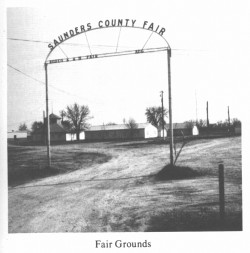 |
| Fair Grounds |
During the year 1929, many important things happened to the society. On July 15,1929, non-profit articles of incorporation were filed with the Secretary of State in Lincoln, Nebraska, for the following purpose: "To educate the general public and to encourage the improvement in all things pertaining to the interest of the agriculturist, the mechanic, the merchant, and the citizen of any calling by aiding such interest that are most conducive to the public good". Horse racing sanctioned by the Nebraska State Racing Commission with a $1,500 purse was one of the features of the annual fair. Walter Saveridge Amusement Company had 27 railroad cars of equipment shipped to Wahoo for rides. Board members at this time were: President, R.C. Johnson; Vice-President, Albert Benson; Treasurer, Albert Gustafson; Secretary, E.S. Schiefelbein; Directors, Frank Hledik, E.T. Borreson, Eric J. Erickson, R.C. Anderson, and G.E. Lanham.
There have been many damaging floods at the fairgrounds, located in the Wahoo and Sand Creek Flood Plain; most serious of these were in 1959 and 1963.
On January 15, 1955, permission was granted by the Fair Board Directors allowing the Wahoo Saddle Club use of the fairgrounds to hold a rodeo. This has been held in connection with the County Fair every year since that time. Don Virgl started a tractor-pull contest in 1963 and has continued this popular event each year.
Partly with the use of Ak-Sar-Ben matching funds and help from Saunders County supervisors many major improvements have been constructed during the last 25 years. Among these were: new steel grandstand costing $17,000.00, $5,000.00 of which was paid by Wahoo Saddle Club, and erected in 1963; New $4,000.00 lunch stand; $4,677.00 metal hog building; $24,000.00 metal commercial building with public rest rooms; $6,500.00 new beef barn; $5,666.00 addition to hog barn; and in 1978 Fair Board and Neumann High purchased 2 portable bleachers to be used by both parties. During 1982, a $70,000.00 concrete block combination office, restrooms and dressing rooms complex was constructed. Future plans call for an all-purpose pavilion approximately 100 x 220 feet to be used by the society as well as the community for many uses.
Presidents of the Fair Board since incorporation in 1929 have been: R.C. Johnson, 1929-1940; E.S. Schiefelbein 1940-1947; Fred Norenberg, 1947-1954; A.J. Vance 1954-1957; Vernon Schmidt, 1957-1974; Don Virgl, 1974-1981; Jack Nitz, 1981-1982; Joe Sanderson, 1982-.
The first three women were elected to the Fair Board in November, 1982. They were Jackie Hladik, Audrey Williams and Carlene Svoboda. by Wayne Edgar
AGRICULTURE
The first farmers in this area were the Pawnee Indians, who raised crops of corn, beans, pumpkins, squash and melons. Their feeling for the land ran deep. They felt part of nature. The land was Earth Mother and that was one reason they did not believe that they owned her, nor that anyone else could. Their use of the land conserved its richness.
The Indians used wind currents to burn long corridors across the prairie. White men called feinish. As soon as the rains came, fresh green shoots of grass would spring up in the burned over prairie. Then deer and other animals came to graze, giving the hunters a ready-made fall hunting ground. The same was true of the spring growth ofgrass. Burning the prairie had another purpose, if lightning caused a prairie fire they could flee to the burned over corridors. The flames also kept the small trees from springing up, keeping the prairies free for grazing and holding back the forests.
The Indian treatment of the land suited the Indians' life style and their tribal goals. The fertile soil and moderate climate served the white settlers in the same way when they came to the lands that the Indians had given up. Good Stewardship of the gently rolling hills of the county is necessary for whichever race occupies the land.
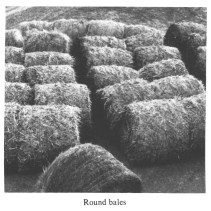 |
| Round bales |
It should be noted that in 1819 the U.S. Government sent an expedition under Major Stephen H. Long to explore the land of the Platte valley. In his report of 1820 about the country he said, "It is almost wholly unfit for cultivation and, of course, uninhabitable for people depending upon agriculture for their subsistence."
Despite Major Long's predictions, Saunders County is primarily an agricultural land. After the Civil War, pioneers swarmed to this desolate expanse for one thing --- land. It was treeless, matted with dense sod and seemingly arid with a climate that ran to extremes of hot and cold. But still they came wanting to make homes. Under the terms of the Homestead Act of 1862, a man could stake a claim to a piece of unoccupied public land by living on it and cultivating it for three years. But many a wife wept as she first saw her husband's choice of a homestead. One young bride, as she saw the lonely expanse of what was later to be Saunders County, urged her husband to turn their covered wagon back toward the muddy Missouri River that they had crossed several days before. But they stayed and the husband became a "sod buster." In a few years what spelled the "good life" for this couple was a well-made sod house, two sturdy youngsters and another baby on the way.
For one young wife, not too long removed from a comfortable home in Ireland, it took lots of courage to hold on. In the early 1870's with two young children and a new baby, her husband became very ill with typhoid fever. Doing all the farm work, caring for a desperately sick husband and two small children and nursing her baby she discovered that her milk had dried up. A few days later, the family's only cow dried up. So twice each day she would take the two small children and the baby and walk two miles to a neighboring lady, also with a new baby, who would nurse her baby. All five members of this pioneer family survived the ordeal.
A cowboy traveling through on the Ox-Bow Trail to the west observed that Nebraska was no place for a woman unless she could "keep a sod house tidy, shoot a snake, and climb a windmill."
In 1875 breadstuffs were high --- 28¢ per pound for salted meat, and 30¢ per pound for butter. At one time, Nels Gibson took a load of corn to Ashland, and succeeded in getting 19 pounds of flour and 10¢ in cash for the load.
Homesteaders found themselves "far from markets, burned by drought, beaten by hail, withered by hot winds, eaten out by grasshoppers, exploited by
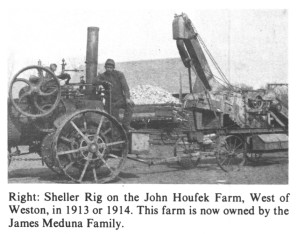 |
| Right: Sheller Rig on the John Houfek Farm, West of Weston, in 1913 or 1914. This farm is now owned by the James Meduna Family. |
page 27
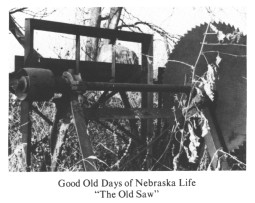 |
Good Old Days of Nebraska LIfe
"The Old Saw" |
capitalists, and cozened by politicians" --- noted the historian of the frontier, Walter Prescott Webb. Still the call for settlers resounded through Europe and eastern America. "Land for the Landless! Homes for the Homeless!" advertised the Nebraska Immigration Association. Railroads were built through the area in the 1860's and 70's and they pushed settlements and sold land for $2.50 an acre.
Windmills sprouted across the grasslands and pumped water to bolster the farmers' hopes, watered vegetable gardens and fruit tree seedlings. New tempered steel plows turned the sod.
They could raise a few acres of wheat and corn; also, potatoes and a garden. The wheat was threshed with a flail or wooden stick and winnowed in tin pans in the wind. It would take five days to take it to the nearest mill to have it made into flour. Corn was ground in a coffee mill or pounded in a wooden mortar. Parched corn was ground and used for coffee. Some years they literally lived on corn.
A new kind of wheat introduced by Mennonite immigrants from Russia's Crimea, hardy enough for this area, helped the settlers. More area was cleared and soon farm families began to enjoy a comfortable standard of living on 120 acres. Many were living off 80 acres. Horses provided the power. By 1886 --- A Farmers Alliance was going strong in Saunders County.
The new machinery --- plows and reapers pulled by lumbering steam tractors --- came to the plains. Barb-wire fences enabled the sod buster to protect his holdings and keep out intruders. These early pioneers carved out a great farming country.
After the drought of the 90's the rains came and farm prices rose. Farmers (and their wives) were frugal and industrious. Markets opened up. World War I created a huge market overseas for their commodities and especially an unprecedented demand for wheat which sold at $2.20, and for a brief period in 1919, for $2.90. Farmers borrowed money and bought more land and machinery.
Then, exports dropped. Farm surplus kept piling higher causing further drops in prices.
The Great Depression caused by the near collapse of the nation's economy in 1929 and the drought of the 1930's almost brought the farmers to their knees. In 1930, 50% of the people owned their land in the county. By 1935 less than half of them owned their farms. Many of these then lost their farms and moved away. The lack of rain did much to hasten the introduction of pump irrigation.
The first corn loan made on the 1937 crop was issued to Nova Z. Sanders who resides north of Ashland and involved 790 bushels of corn. Loan price was 50¢ per bushel.
Prosperity returned during World War II. Total farm income increased 250% from 1939 to 1945. Surprisingly, this burst of prosperity occured in spite of a tremendous loss of some 800,000 workers. Farmers were farming more economically and getting better yields from their crops. Advances in scientific knowledge had brought them better fertilizers and feed. Mechanization caused an even bigger boost in farm production. In 1945 the average farmer produced enough to feed himself and 13 other people, as opposed to nine in 1940.
Before long, farming would come to be known as "agri-business." Saunders County has remained to this date strictly "agricultural." Her fertile land is well adapted to diversified farming with its three topographical divisions --- the lossial and glacial uplands, the alluvial terraces, and the bottom land. The silt loams of the old Todd Valley that extends in a southeasterly direction across the county with its creek valleys and terrace lands are unmatched in their ability to produce quality crops. The mean elevation of the county is 1,250 feet.
A severe drought in the 50's caused great hardship and many wives returned to the jobs they had before marriage to supplement the family income. Many men, too, held down an extra job off the farm. They called it "moonlighting."
During the late 70's the "cost-price freeze" caught up with the business of farming. Prices for their produce started slipping and cost of production steadily rose. After 1980, it had come to be an industry in great trouble.
Today, 1983, farmers and farm-related businesses are having a difficult time making ends meet. Many times the cost of raising the crop is greater than the income. Profits have all but disappeared and "parity" seems a very distant dream.
The future will have to bring a better overseas export trade, and relief from the outlandish cost of production. There must be better conservation practices and more concern by all segments of the economy to preserve their heritage. However, great strides have taken place. For example, today's beef animal grows to market weight in 100 days and weighs in at 200 pounds more than his 1950's predecessor. Many farmers have taken hog raising out of the mud, dust and dirt and gotten it inside. They have developed a "far better understanding of the economic benefits of using certain breeds in crosses."
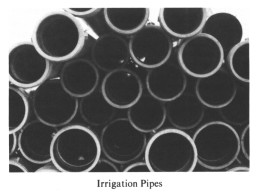 |
| Irrigation Pipes |
University of Nebraska authorities state that many more graduates of agriculture college are needed. Computers, no doubt, will play a big part in agri-business in the future. The results of the PIK program (Payment In Kind) will have to be evaluated. It has already idled about 88,000 acres in the county. In the meantime, other agricultural groups seem to be getting on the "PIK-Kick." And throughout it all, Saunders County farmers never run out of hope.
R.N. Houser, an early County Extention Agent, summed it all up back in 1924 and tells why Saunders County is "unique in the world." He said: "To know Saunders County, then, is to realize that she is a county of thrift and prosperity in every sense of the word. Visitors say it is a county of "home-builders," and what better eulogy could be pronounced --- one which combines in one thought all factors of location, soil, climate, and, last but not least, the type of people who have, through their willing cooperation, built up a contented, prosperous commonwealth."
Notwithstanding, farming in the 80's is a "tough row to plow."
AGRICULTURE STATISTICS
U.S. Census on Tractors on Farms -- Some were garden tractors also.
Nebraska -- Year 1920 -- 11,100; 1930 -- 40,729; 1940 -- 70,761; 1950 -- 127,154
Horses and Mules on Farms in U.S.: 1931 -- 18,468; 1950 -- 7,781.
By the year 1870 -- 2000 firms in the U.S. were manufacturing some sort of agriculture machinery for farm use.
Grain binders -- more than 150,000 grain binders in mid 1920's. In 1938 still 1,250,000 binders still in use on American farms.
Threshing machines -- typical steam outfit could thresh 800 bushels a day in 1870's. Steam power declined during World War I.
Combine sales -- In the 1930's came the combine sales and threshing scenes were soon to become just a memory to the farmers.
HISTORY OF SOIL
CONSERVATION SERVICE IN
SAUNDERS COUNTY
The great dust storms in 1934 and 1935 which blew soil particles from the midwest as far as 300 miles out into the Atlantic Ocean prompted quick and swift action by the United States Congress. Provisions were initiated to make assistance available to rural farmers.
In order for the Soil Conservation Service (SCS) to be available to the farmers, a sponsoring organization had to be organized. In 1945, the Saunders Soil Conservation District was formed. This organization sponsored the SCS.
The purpose of the SCS is to assist landowners and farmers plan and use each acre to its fullest potential based on the soil capability of each acre involved.
During the early years soil conservation practices caught on fast. Farmers were eager to save their eroding soil in order to produce increased yields. Hundreds of miles of terraces and grassed waterways were constructed. As new hybrids, fertilizers, insecticides and herbicides were developed, it became more difficult for a farmer to see the clear-cut results from conservation practices. Larger machinery called for some changes in the design of terraces and waterways. Parallel terraces became popular. Many farmers rebuilt their systems as many as three times to keep up with the changing times. The newest terrace system presently being used by a few farmers is the underground tile, replacing the grassed waterways.
Conservation plans have been developed on most farms based on the individual farmers needs. In the early years most mechanical conservation practices were performed by the farmer himself. Today, most all mechanical practices are performed by conservation contractors who make their living constructing these practices.
Conserving the soil covers a host of practices. Many are easily observed but others are not. Mechanical practices most used in Saunders County are Terraces, Grassed Waterways, Diversion Terraces, Dams, Land Leveling, Open Drains, Tiling, Reuse Pits and Irrigation Tail Water Recovery Pits.
Vegetative practices include Contour Farming, Cropping Systems, Pasture Management, Tillage Practices, Irrigation Management, Windbreak Plantings, Fish Pond Management, Field Boarders, Recreation and Wildlife Habitat Management and Critical Acre Plantings.
The SCS was instrumental in assisting the local people with the organizing and planning of the Swedeburg Watershed in 1953, which was the first watershed project completed in Saunders County. Later on, Cottonwood Creek Watershed, Clear Creek Watershed and North Oak Watersheds were organized. Construction is nearly complete.
The "Soil Survey" book of Saunders County was published in 1965. The field work was accomplished primarily by the SCS prior to 1959. Each farmer in the county has received one of these books and many second generation farmers also. It provides farmers and owners with a tool to plan management that will protect their soils and provide good yields.
Personnel of Saunders County SCS, past and present are: William J. Ralston, Wallace E. Johnson, Virgil R. Johnson, Loran M Greiner, Howard Sautter, Dean E. Taylor, Jack Smith, Robert D. Foster, William B. Whitney, Archie L. McMaster, G.A. Clark, Andrew J. Andresen, John Nincehelser, Valarian Bohaty, Lorain Steiner, Eugene A. Daniels, Joe R. Kund, Harold Kuenning, Richard
page 28
Clemens, Douglas Uehling, Cloyd D. Boydston, Robin S. Zucollo, and Kenneth Kotera. Submitted by Cloyd D. Boydston, District Conservationist Saunders County Soil Conservation Office
SAUNDERS COUNTY FARM
BUREAU
Farm Bureau of Saunders County was organized in 1919 with its purpose to sponsor the Extension Service. Under a new law passed by the legislature a county must have 300 bona fide farmers sign a petition asking the county commissioners to appropriate funds to support the Farm Bureau. This new county organization started out with 335 members signed up with its main purpose to promote the Extension Service and boys and girls club work. Farm Bureau continued to serve the county in this way until 1944 when it reorganized to become an independent farm organization with dues paid by voluntary members without support from state and local government.
Farm Bureau adopted the following purposes in its constitution. "Farm Bureau is a free, independent, non-governmental, voluntary organization of farm and ranch families united for the purpose of analyzing their problems and formulating action to achieve educational improvement, economic opportunity and social advancement and, thereby, to promote the national well-being. Farm Bureau is local, county, state, national, and international in its scope and influence and is non-partisan, non-sectarian and non-secret in character."
On October26, 1944, the first board of directors were elected under the reorganization. They were: president, Roland Nelson, Mead; vice-president, Bill Widman, Mead; Secretary, Harold Nelson, Mead; treasurer, Ben Widman, Mead; News Reporter, Wallace Thorson, Mead. Local unit Farm Bureaus were organized in many parts of the county. Some of those units were Marietta, Pohocco, Merriman, Leshara, North Side, District 70, Wann, Ashland, Ithaca, and Cedar Hill.
One of the first resolutions passed at the first annual meeting was that every unit appoint a road committee to study the road problem and make definite recommendations for improvement. In the next several years the County Farm Bureau led the change from a three county commissioner form of government to the present seven-member board of supervisors.
County presidents serving since that time are: Roland Nelson, Mead; Ben Widman, Mead; David Lindgren, Malmo; Ambrose Johnson, Mead; Gail Pollard, Ashland; Richard Gooding, Ithaca; Joe Hageman, Ithaca; Clarence Ecklund, Colon; Henry Hrdlicka, Wahoo; Phil Caha, Wahoo; Glen Rosengren, Colon; Rudy Caha, Wahoo; Elwyn Johnson, Mead; Fred Houfek, Wahoo; Medford Barry, Colon; LeRoy Nelson, Mead; Charles Caha, Wahoo; and Alfred Peterson, Malmo, the present president of Farm Bureau.
We have had two county members move up to State Farm Bureau positions. Roland Nelson, Mead was elected to the State Board in 1946. He was elected vice-president in 1949 and served in this position until 1966. He then was elected president and served for six years, until 1972, when he retired. Richard Gooding, Ithaca, has been employed by the Nebraska Farm Bureau, as director of Public Affairs from 1955, and is still serving in that position.
At the present time, the Saunders County Farm Bureau has a county office located in the Wahoo Commercial Park. This office provides services not only for our county activities but also for other services to members, the largest service being insurance. Other services are: Tires and Batteries, Oil and Grease, Fruits from Florida and Michigan, and Farm Records. Each year two county high school youths are sent to a State Citizenship Seminar.
Another activity of Farm Bureau is the Young Farmer and Rancher program. Every year a young farm couple under age 30 is chosen and sent to the State Young Farmer and Rancher convention. There is also a women's organization under the leadership of the Women's Chairman. The present board of directors consists of president, vice-president, secretary-treasurer, youth chairman, women's chairman, delegate chairman, and ten directors elected from five districts in the county. LeRoy E. Nelson
SAUNDERS COUNTY
PORKETTES
The Saunders County Porkettes were organized in 1974 as an auxiliary to the Pork Producers for the purpose of promoting our husbands' product "Pork". The group is made up largely of wives of Saunders County Pork Producers and other interested individuals. The first Board of Directors elected were: Mary Ann Kavan, Wahoo; Corrine Kruse, Cedar Bluffs; Judy Zakovec, Cedar Bluffs; Millie Ondracek, Fremont; Valerie Witte, Yutan; and Pauline Pallas, Ceresco. The Porkettes and Pork Producers serve a ham and egg breakfast at the Saunders County Fair in August, sponsor an open class hog show, have informative meetings and recognize youth for their swine achievements in 4-H work, and have an annual banquet.
The Pork Producers organized in 1973 for the purpose of promotion, for research of the pork industry, to encourage voluntary checkoff, and to keep the pork producers informed of any new regulations. The first members elected to serve on the Board were: Vennie Kavan, Wahoo; Joe Ondracek, Fremont; James Snyder, Fremont; Henry Johnson, Mead; Ben Pokorny, Wahoo; Fred Pallas, Ceresco; Willard Witte, Yutan; Stan Shavlik, Linwood; and Dave McReynolds, Ashland.
The membership is mostly pork producers and associate members who are interested in promoting and helping the pork producers.
Lori Langemeier of Mead represented the Saunders County Pork Producers in the 1983 Pork Queen Pageant at Grand Island. (Jan.1983)
MIDLAND DAIRY WOMEN
The Midland Dairy Women's Chapter, a local chapter of the Nebr. Dairy Women's Association, has been launched in Saunders, Dodge, Douglas, and Washington counties.
This organization's purpose is to help encourage use of all dairy products by the public and by industry, to improve consumer relations, provide education for the use and nutrition of dairy and to help further the growth of the Dairy Princess Contest. It is also a vehicle in which the dairy women can be updated and educated in areas pertinent to their occupation through workshops of different sorts.
The new chapter is well-organized, and elected officers are: Pres., Maggie Pfeiffer, Arlington; Vice Pres., Pat Chapman, North Bend; Sec., Donna Johnson, Mead; Treasurer, Margie Vanek, Prague; Publicity, Beth Anderson, Arlington.
Projects in the future will include: participation in state activities, educational and promotional booth at fairs and bazaars, and workshops to inform us of new and interesting dairy developments.
WIFE
The first meeting of the Women Involved in Farm Economics, WIFE, was held on Jan. 19,1977. The purpose of the WIFE chapter was to promote agriculture and strive for a 100% parity of farm prices by legislation and education of the public of the farmers' plight.
Towards this end, the first action taken was to write President Jimmy Carter and Representative Virginia Smith protesting railroad rate hikes made by the ICC.
The following people were elected to these positions: organizational president, Rose Storm; executive vice president, Mary Pitzel; steering committee co-chairmen, Evelyn Houska and Doris Karloff; steering committee members, Laverne Vavak, Adeline Hohl, and Luella Barry; executive secretary, Florence Hass: corresponding secretary, Mary Schulz; public relations, Jackie Romans; and publicity chairmen, Pauline Heuerman and Leanne DeCoste.
Today, WIFE work continues. Members talk to legislators and hold meetings explaining government programs and financial problems of the farmers.
The following are the current officers: Chris Eliason, president; Rose Storm, vice president; Darlene Hanson, secretary; and Helen Kremlacek, treasurer. By Chris Eliason
THE MEMPHIS STATE
RECREATION AREA
The Memphis State Recreation Area, located at Memphis, is composed of 160.36 land acres and 52 water acres.
Dates of land transactions are given below: Deed dated 4/14/1930; 146.68 acres: $15,000 --Tanner; Deed dated 12/12/1950; 10 acres: Thoms; Gov. Approval 7/19/50 $2,000; Deed dated 8/26/53; 28.58 acres; $5,716; Miller; Gov. App. 7/15/53; Deed dated 8/26/53; 10 acres; $2,006; Schulz and Huhlman; Gov. Approval 7/15/53; Deed dated 8/26/53; 20.07 acres; $4,014. Semenec; Designated 3/11/60.
This recreation area provides activities of hunting, fishing, boating -- either row or elect.
Facilities in the area include picnic and playground equipment which is enjoyed and used by many people throughout the year.
Lodging includes 122 campsites and 62 camper pads. There are also about 60 non-designated campsites. There are no electrical hook-ups.
On the grounds one can also find a snack bar, supplies and rental boats. It is a busy place in the summer from Memorial Day week-end through Labor Day weekend. Campers come from many surrounding towns to enjoy this lovely recreational area.
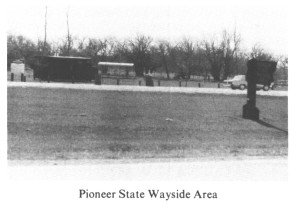 |
| Pioneer State Wayside Area |
PIONEER STATE WAYSIDE
AREA
According to the Nebraska Game and Parks Commission, the Pioneer State Wayside Area consists of 8.1 acres, purchased from Ruth and Theodore Lindquist on 5/22/70.
Purchase price for this area was $2,500. It is located, four miles north of Ceresco or two miles south of Swedeburg on the east side of Highway 77. It is located in Section 9, Township 13 N, Range 7 E of the 6th PM.
UNIVERSITY OF NEBRASKA
FIELD LABORATORY AT MEAD
A twenty-year developmental program, called the Field Laboratory, was prepared by the University, the area to be used for research, extension, and demonstration purposes. The objective was, and is, to lower the cost of production and increase the quality of farm products.
In April of 1962, the General Services Administration transferred 9400 acres of the south portion of the Nebraska Ordnance Plant at Mead to the Uni. The Uni. had to assume responsibility for 464 buildings, most of which were in the four load lines, and also had to accept responsibility for the "contaminated" areas of load lines. The Uni. further accepted full responsibility for the water, sewer,
page 29
electrical lines and the road systems.
Warren Sahs became supervisor of the newly created Field Laboratory. In rapid succession came the transfer of research projects from the Agricultural Campus in Lincoln: beef cattle, the dairy herd, a portion of the swine herd and sheep; along with agronomics, horticultural, agricultural engineering, forestry, plant pathology and foundation seed projects. Tractor Power and Safety Day, Mum Day, Beef Day, 4-H Clubs, FFA activities, soil judging contests and twilight crop meetings followed closely thereafter. Animal disease projects of the Veterinary Science Department were the next translocation from Lincoln. The Eppley Institute, College of Medicine, Omaha, has a sizeable animal breeding farm on Load Line 4, with emphasis on cancer research.
| 
